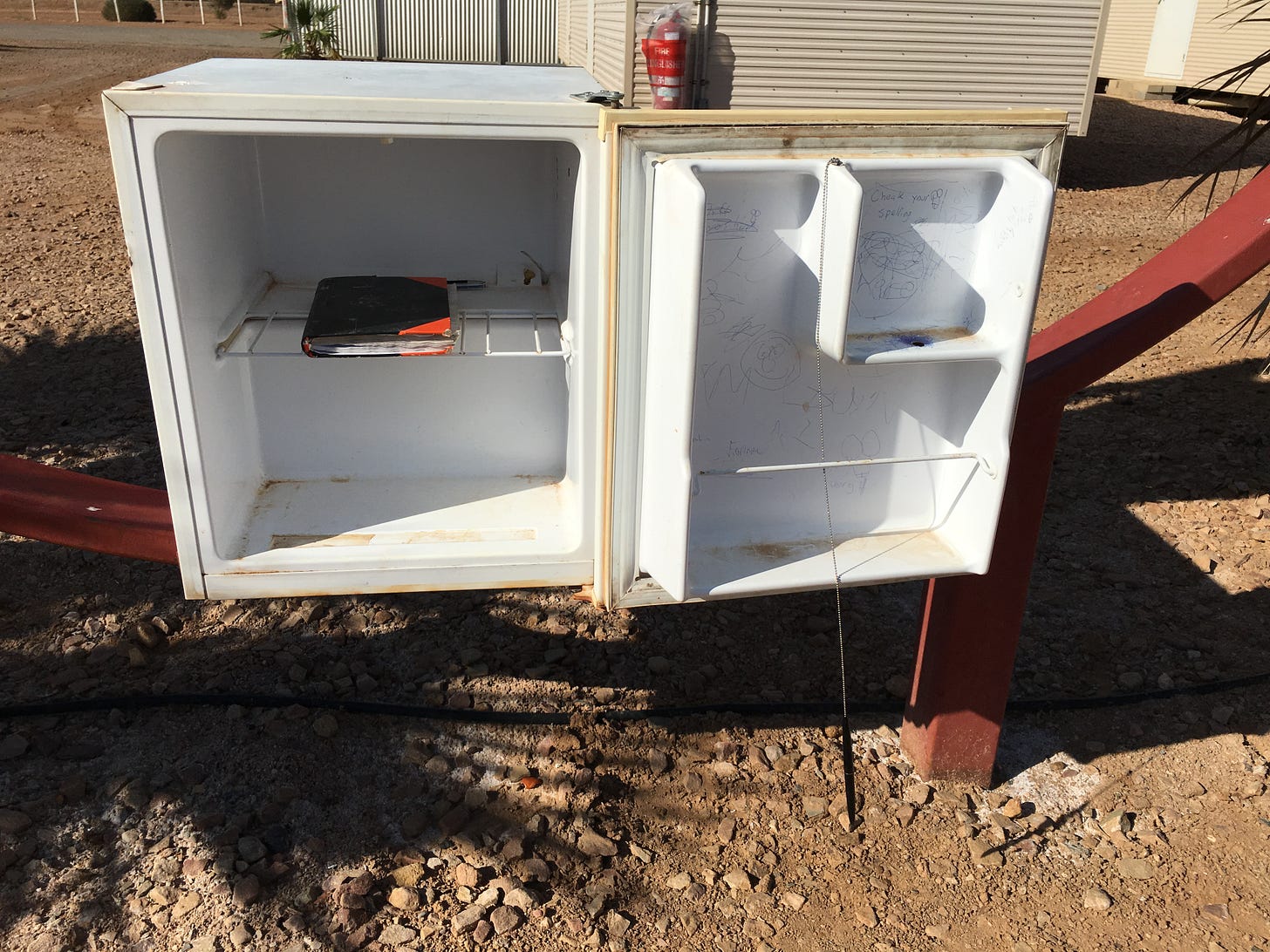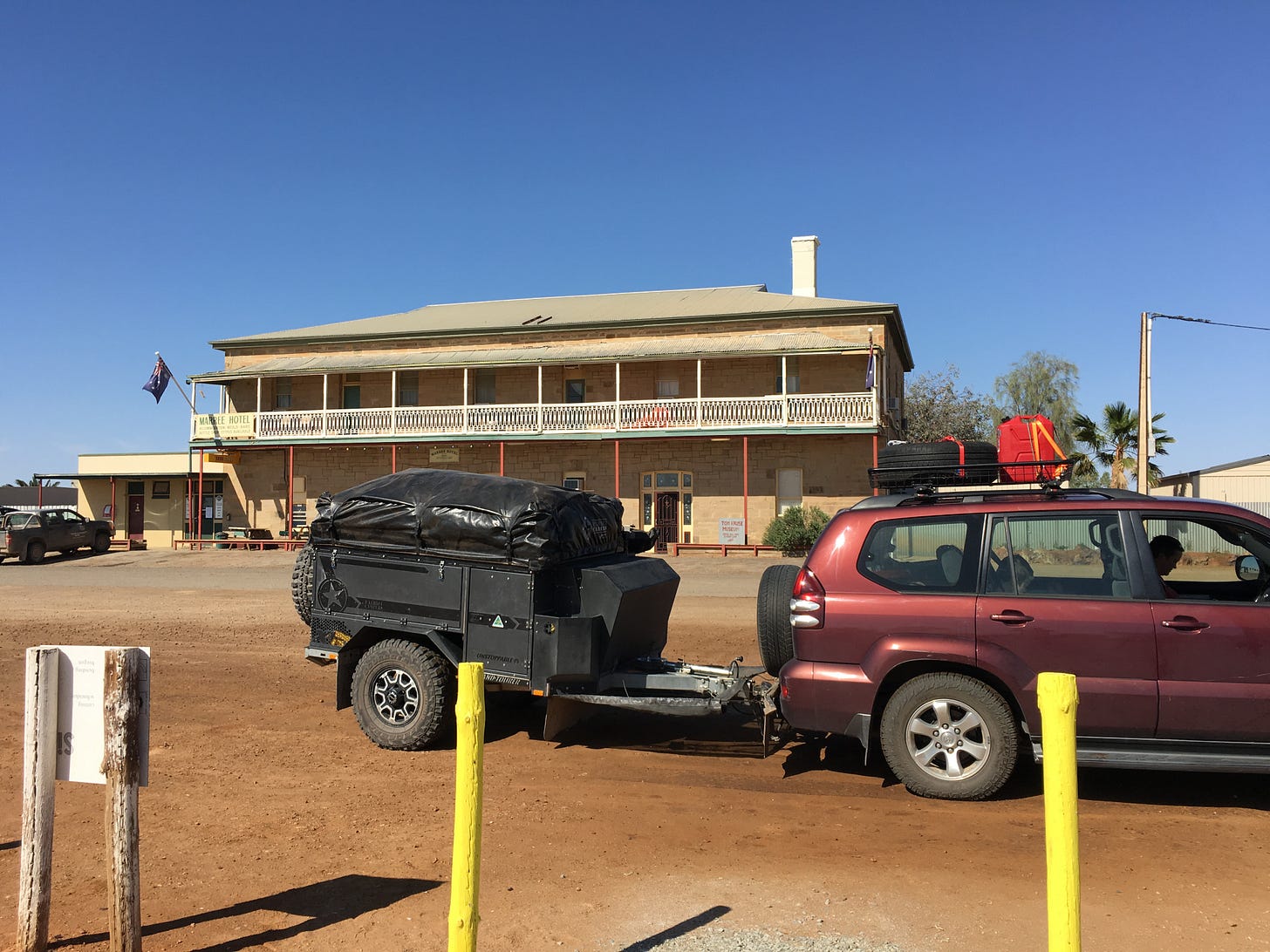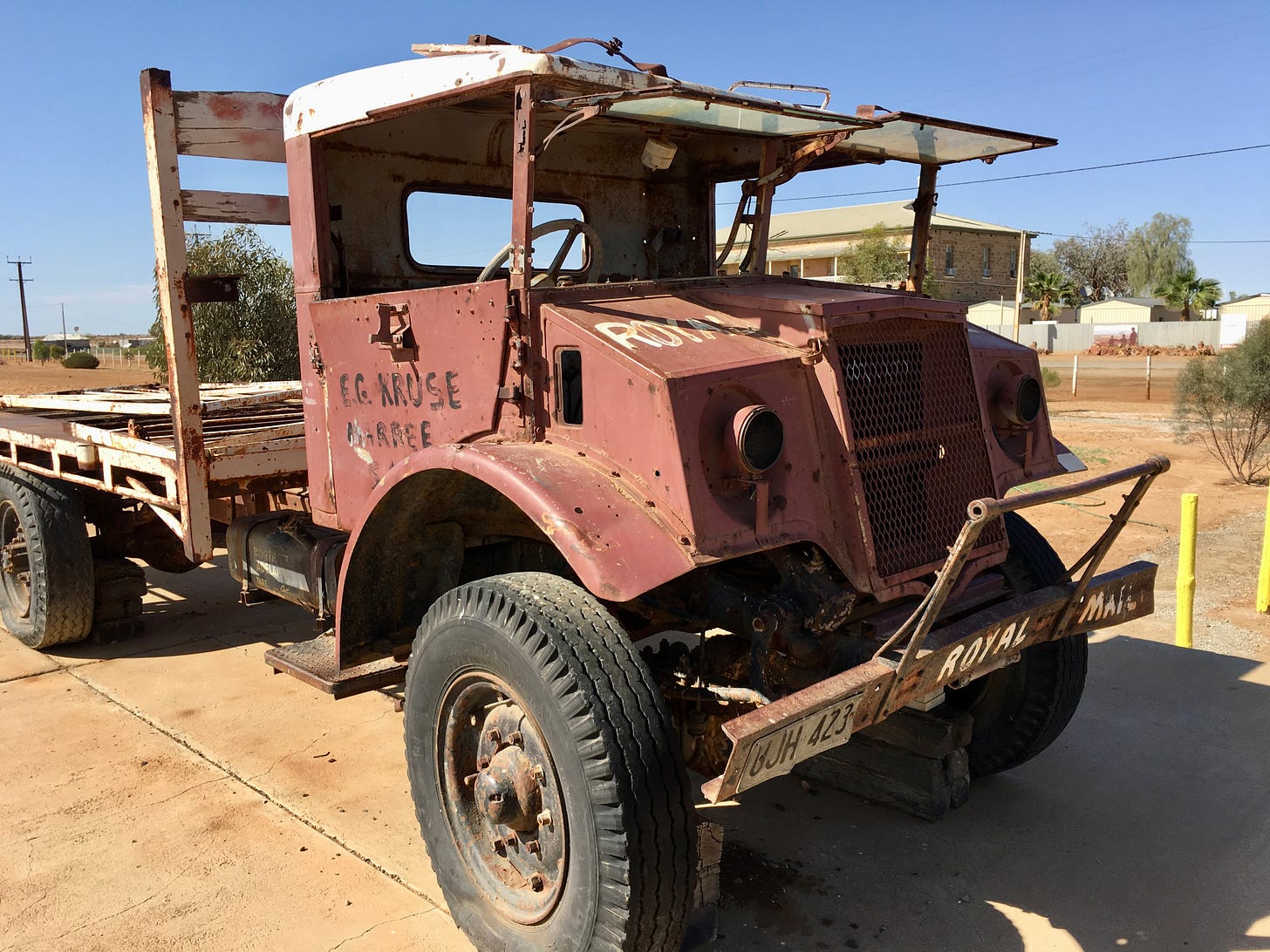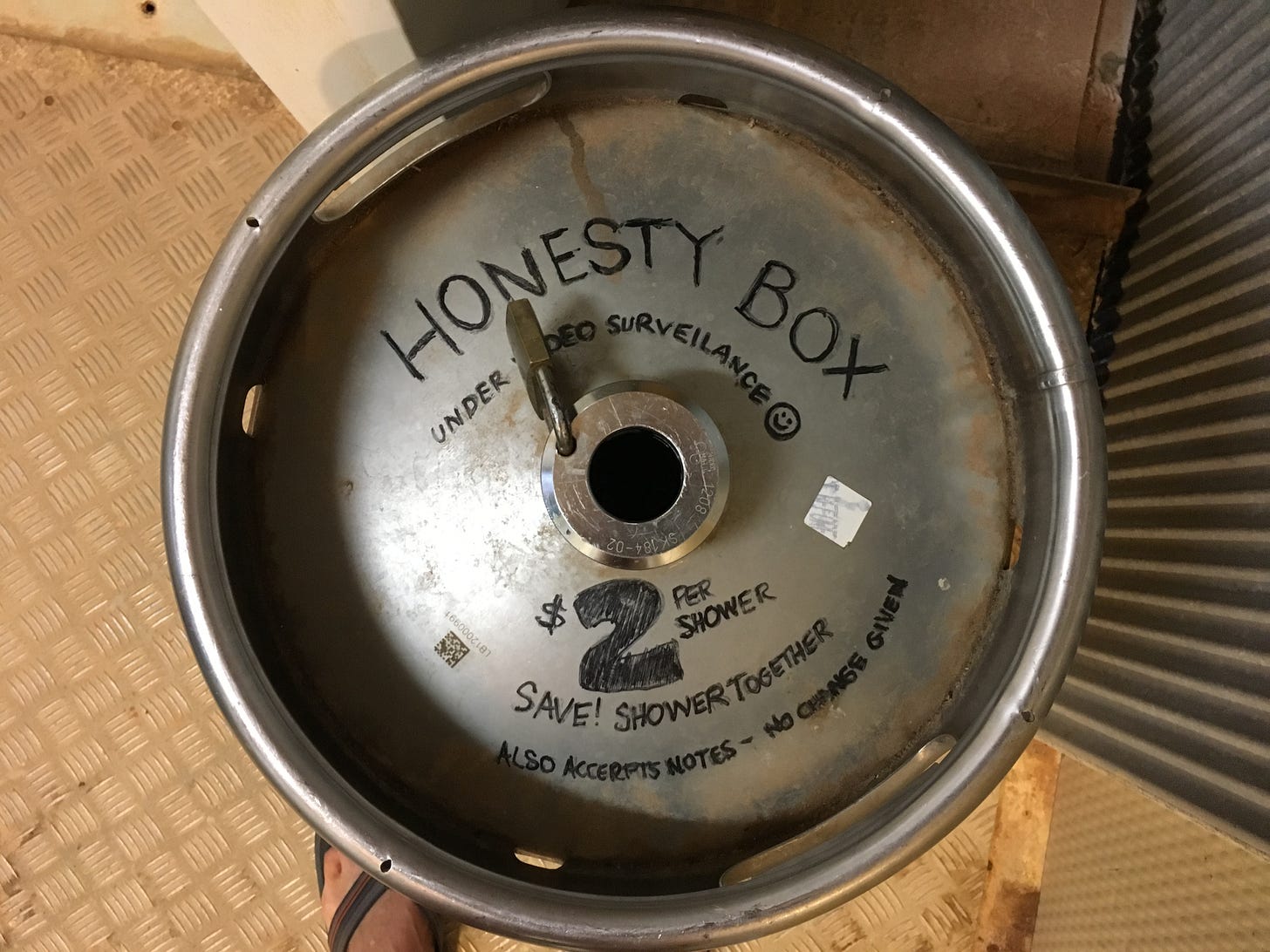G’day!
Welcome to Letters From the Road, and letter number 6. Today we’re in Marree, South Australia. It’s a place with in the middle of the desert yet has a yacht club that’s in the middle of the desert. A place where you can pay $175 for a room at the Marree Hotel or sleep in the parking lot for free. A town that was once the prosperous home of a community of camel drivers.
For those of you for whom this is your first letter, welcome! Good on ya for signing up. Letters From the Road is the story of a family road trip in Australia, told one weekly installment at a time using my journal entries written during the trip. You’ll probably figure this out, but I thought I may as well mention that the quoted bits below are the journal entries, and the rest is me filling in the gaps.
And if you’ve just joined us, you’re not that far behind - the first five letters can be found here in a pile of odds and ends underneath the seat in front of you.
With that, your next letter is here.
The word of the day is detritus.
Detritus, noun.
Definition 1 - miscellaneous remnants: odds and ends.
The world is full of detritus. Look around and you’ll start to see it. Piles of leaves clogging the gutter after a rain. Rubbish stacked in the alley behind your favourite restaurant after a Saturday night. Sloppy 20-somethings scattered about a tram stop at 2am after last call.
Road trips, particularly long ones, breed detritus.
Like coal plants and belching cows are significant generators of greenhouse gasses, teenagers can be found up toward the top of the list of producers of odds and ends. It’s just what most kids do: pick things up, much of it that they shouldn’t like pieces of glass and anything that’s wet from an unknown source.
My boys Henry, 13, and Oscar, 11, had just spent several months crammed into the backseat of a Toyota Highlander, surrounded by their teenage detritus. I don’t know how Henry had any leg room with all of the wrappers, apple cores, drink bottles, cigarette butts and the like that he stuffed into the pocket on the back of his mother’s seat. Oscar was the same, though more so due to the large stack of books he’d kept under his feet along with a mesh shirt he made out of an old firewood bag.
We were no strangers to road trips, even aside from our travels in early-2019 when we had roadtripped around the U.S. and South America. Semi-regular 10 hour trips were made across the Nebraska wastelands bewteen our home in Denver, Colorado and where our family lived in Iowa. Another time, when the boys were 3 and 1, we trekked three straight days from Colorado to the depths of south Florida for a holiday. That was likely when Henry learned to pee in a bottle while in a moving vehicle.
Even looking back at my childhood, I can recall taking overly long road trips. When I was around 8, our old red Chevrolet station wagon with fake wood paneling was loaded up with my two brothers, suitcases, and an old Belgian woman named Paula. We drove from Iowa to Tucson, Arizona, and I recall that Paula was not fond of the road, and we had to make stops on the side of the road so she could vomit. That trip could possibly have been used as the basis for the movie Vacation.
So we knew road tripping, but our drive around the western half of Australia had only just begun and thus we’d not had much opportunity to collect enough odds and ends to steal any legroom from our boys. And yet, the driving was already starting to wear on me.
7th October 2019, Marree, South Australia
We drive a lot. I mean damn. We pulled out at around 11am, despite a pretty good takedown. Then drove until 4 pm to Marree, a two-street-and-a-couple town in the middle of nowhere South Australia. It sits at the start of something called the Oodnadatta track, which is basically a gravel road in the middle of nowhere with an awesome name. Oodnadatta! I wonder what it means?
Oodnadatta, I’ve since learned, is likely an adaptation of a local indigenous word "utnadata" meaning "blossom of the mulga", the Mulga being a short shrubby tree that grows in the desert, and also the sound you make when you’ve got a chesty cold or when there’s a piece of corn caught in your throat.
Oodnadatta is also the name of the track - calling it a road would be overly generous - that runs between the desert outpost of the same name and the town of Marree where we’d stopped for the night.
On the surface, and as I observed in my journal, Marree is a dusty town of nothing, a place that shouldn’t be there, sitting at the end of the paved road and surrounded by a sea of sand and rocks. But it has an interesting history in the context of Australia.
Australia’s a young country. Captain Cook turned up a fleet of boats loaded with convicts in the late-1700’s. At that point Europe, by contrast, was at the height of its powers, and the U.S. had grown up enough to decide that it needed a civil war. Australia was still figuring itself out, trying to find its way as a big island and budding country on the other side of the world from the English speaking west. Because it’s so young, Australia, as much as any place I’ve visited, is full of remnants of growth, evidence of the building blocks and infrastructure that it took to build a country from scratch.
Marree is one of those remnants. Early growth in Australia was similar to the western expansion of the U.S. Pastoralists would grab lands wherever they could, establishing large stations - farms - for grazing cattle and sheep. I’m continually baffled by the logic of establishing stations in the middle of a desert, requiring that they are enormous in size because there’s so little for the livestock, much less the people, to eat, but that was the thing to do in 1800’s Australia.
Marree became a town in the first place because of water. The springs found in the vicinity made it an important outpost that was used to ferry supplies to those remote stations of the Australian centre. In the late 1800’s, a rail line was built to Marree, increasing the town’s importance as a commerce hub. The rail line made getting to Marree more pleasant, but travelling past Marree, into the oppressive sandy wilds of the Outback, was still an issue. So someone decided to bring in experts: camels and some guys from Afghanistan and Pakistan, to ride them.
This proved wildly successful, despite it sounding like a harebrained scheme and despite an inauspicious beginning that’s worth mentioning. The story involves an English gentleman named John Ainsworth Horrocks and a camel named Harry. Horrocks decided that he wanted to be an explorer, and not finding much to explore in the small country town where he lived in England, he caught a boat for Adelaide. There was plenty of Australia left to explore in 1839 when Horrocks arrived, and Adelaide was the perfect jumping off point for a trip north into the Outback.
Harry the camel arrived in Australia at about the same time as Horrocks. Harry had been imported from the Canary Islands along with several of his camel mates, all of whom died on the ocean journey. I am sure this was tough on Harry, but with no other competition, this gave Harry the title of first camel in Australia. It did not take long for him to find work in Horrocks’ exploration party.
But Horrocks’ adventure ended prematurely one morning when Harry shot him. Horrocks was loading his gun when Harry moved, causing the gun to go off. As Horrocks wrote, at some point during the agonising three days that preceeded his death, “I was screwing the ramrod into the wad over the slugs, standing close alongside of the camel. At this moment the camel gave a lurch to one side, and caught his pack in the cock of my gun, which discharged the barrel I was unloading, the contents of which first took off the middle fingers of my right hand between the second and third joints, and entered my left cheek by my lower jaw, knocking out a row of teeth from my upper jaw." Sadly, Harry the camel was also shot, though not on accident, for his accidental lurch.
You might have thought that this would doom the Australian camel experiment, but on the contrary. Camels have done quite well for themselves. Since Harry was first brought to Australia in the mid-1800’s, the Australian camel population has expanded to over a million animals today, growth for which they’ve been awarded the title of ‘feral pest’, something reserved for only Australia’s most revered animals like cane toads, rabbits, and the cats that roam my neighbourhood and try to run into my garage when I’m not looking. The Northern Territory has even put out a YouTube video entitled The Feral Camel: Hardy Pest that features grainy video of camels running backed by a grim soundtrack.
The cameleers, as the middle eastern camel drivers were known, were successful as well, playing a key role not only in Outback transport, but in the construction of the first rail line and first telegraph line that crossed Australia from south to north.
The cameleers were later replaced by burly men driving trucks out of Marree to deliver mail and supplies to desert outposts, places with names like Mugerannie, Mirra Mitta, and Birdsville. One of these drivers became semi-famous because a documentary was made about his postal route. The Back of Beyond (1954) starred such big names as Old Joe the Rainmaker, Jack the Dogger, and the postman himself, Tom Kruse. The movie generally follows Tom and two helpers, one who rides in the cab of the truck next to Tom, the other who rests in an armchair that sits atop all the cargo in the back of the truck, on one of their delivery runs from Marree to Birdsville. As engrossing as a documentary about a 1950’s mailman might sound, it’s nonetheless charmingly weird. At one point in the film, Tom dances with a mannequin pulled from the back of the truck, and at another they camp with Jack the Dogger, named such because he’s out shooting dingoes for their pelts.
Tom used a truck called the Leyland Badger to make his Outback deliveries. One of the original Leylands is gently rusting away in the middle of Marree, across the road from the parking lot where we stopped for the night.
Detritus, noun.
Definition 2. Organic matter produced by the decomposition of organisms.
Physical odds and ends finding their way into your car are one part of a road trip, but a long time spent on the road also produces the less visible but much more egregious form of detritus, that of our own wasting away.
To be sure, the act of spending several hours a day in close quarters can be a joy, and something I find that is often missed in our normal day to day family existence. We talk about the simple things like what’s out the window or about bigger things in life, we share haphazard meals together, we bond through the shared experience of the journey.
But spending so much time together in close quarters also grinds you down, makes you yearn for time alone, and slowly causes us to decompose until something small like eating an apple ends up starting a dumpster fire.
Also rousing was our arrival in town. Oscar started it all by chewing his green apple like a sloppy turtle, which Henry hated so much he hit him with a book. Katie flipped out to an extreme level, screaming at Henry to give her his book and his iPod, now, now, now!
Once she had his book, she threw it at him.
Then they argued, and Henry only got more inflamed, finally squeezing his hands together and screaming. I told him to get out of the car, which he did then slammed the door extremely hard, sat on the dusty ground and put his head between his knees.
I have a picture of Henry sitting miserably in the dust on the side of the road, his only company being a scrawny gum tree and a wooden camel that’s behind him and a wire fence. It’s a sad photo, and looking at it brings back all the feelings from that moment.
I’d like to say this was an isolated incident, a product of us driving a lot. I mean damn. And it partially was, as we’d all worn away to the extent that the car was filled with our detritus, creating a situation like a drought crippled forest in a lightning storm.
That certainly didn’t help, but situations like this had happened before. Katie and Henry had a tempestuous relationship that extended way back, probably to the point where Henry was able to tell her no. They both love each other deeply, but it’s a tough love sometimes because they are so much alike. They both excel at being stubborn, and when they’re stubborn together things don’t go well.
Above all, Katie wants the best for her boys, and to that end is not afraid to advise and consult and prod and lecture when she thinks they have gone astray and need orientation. Henry, however, does not often want advice, and - like me - would prefer to avoid confrontation. He’s also an emotional kid and the emotions can run really hot, like when you’re driving your Honda Civic around town without getting it out of first gear. I think I have a pretty good sense of what gear he’s in, and I can tell when I can light him up for doing something stupid, and when steppping on the pedal would cause the engine to blow. Katie, however, tends to have a heavy foot.
The book incident was a function of Henry’s impetuous nature, the heavy foot, and also the detritus that had built up in the car after six days and 1,600 kilometres on the road.
So what do you do after an episode like that, one that really makes you stop and take a breath, adrenaline making you hyper aware of everything that’s going on around you?
You go to the pub.
So we’re here, camped behind the Marree Hotel in a dusty lot and not paying a dime. The hotel is good. A decently kept up place which serves grossly overpriced food along with cold beers and a rousing time for a Sunday night. The National Rugby League (NRL) Grand Final is tonight, a match between the Canberra Raiders and the Sydney Roosters, so there’s a few people in the pub.
A free place to camp, cold drinks, and some sport on the telly - the superbowl of the Rugby League, no less: those things are enough to take your mind off of some book carnage that took place earlier in the day. Throw in a cheap shower and I am a satisified man.
I think it didn’t take much for me, though, as my mind was elsewhere, thinking ahead to the Oodnadatta Track the next day. Tomorrow we’d be leaving the paved roads, heading off into the deeper Outback, a place that in Tom Kruse’s day they had a name for that I think is good description of how I was feeling at the time. They called it, the Never Never.







